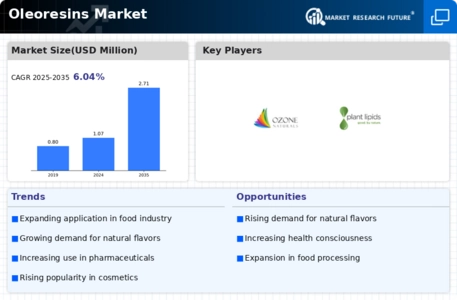Oleoresins Size
Oleoresins Market Growth Projections and Opportunities
The Oleoresins Market is influenced by a myriad of factors that collectively shape its dynamics and growth trajectory. One pivotal factor is the increasing demand for natural flavor and color enhancers in various industries such as food and beverages, pharmaceuticals, and cosmetics. Oleoresins, derived from plant materials, offer a concentrated form of natural flavors and colors, aligning with the rising consumer preference for clean-label products. The growing awareness of the health benefits associated with natural ingredients has driven the demand for oleoresins as a viable alternative to synthetic additives and colorants.
Global economic conditions play a significant role in shaping the Oleoresins Market. Economic stability, consumer purchasing power, and international trade dynamics impact the pricing and availability of raw materials, ultimately influencing the market. For example, fluctuations in currency exchange rates and trade policies can impact the cost of importing or exporting oleoresins, affecting market competitiveness. Economic factors are crucial considerations for both suppliers and manufacturers operating in the global oleoresins industry. The Oleoresins Market is poised for substantial growth, with a projected Compound Annual Growth Rate (CAGR) of 6.04%, reaching a market value of 2.27 billion by the year 2030. Oleoresins, derived from the extraction of spices using non-aqueous solvents, exhibit both volatile and non-volatile characteristics. Notably, these oleoresins retain the essential properties and characteristics of the spices from which they are derived. With a robust base flavor and a nuanced, complex flavor profile, oleoresins have gained prominence in the beverage industry.
One of the driving factors behind the increasing demand for oleoresins is their ability to add natural color to beverages, contributing to their popularity in the market. This dual functionality of providing flavor and enhancing the visual appeal of beverages has propelled the growth of the oleoresins market. The versatility of oleoresins, stemming from their diverse varieties, presents an opportunity for manufacturers to create innovative and improved natural foods and flavorings. This adaptability aligns well with the evolving preferences of consumers seeking authentic and natural ingredients.
The beverages industry, in particular, has witnessed a surge in the use of oleoresins due to their great base flavor and ability to impart complexity to beverages. Beyond beverages, oleoresins play a crucial role in the culinary landscape. Manufacturers are increasingly opting for oleoresins in the preparation of marinades and other spice forms, replacing traditional flavoring marinades. This shift is not only driven by the desire for enhanced flavors but also by the convenience and consistency offered by oleoresins in various applications.
Furthermore, oleoresins serve as key ingredients in the production of a range of culinary products, including sauces, marinades, mayonnaise, and pickles. This application versatility has contributed significantly to the growing demand for oleoresins across the food industry. The ability of oleoresins to enhance the taste, color, and overall sensory experience of food products has established them as valuable ingredients for manufacturers seeking to meet consumer demands for natural and flavorful food options. The agriculture sector, weather patterns, and environmental factors contribute to the availability and quality of raw materials for oleoresin extraction. The cultivation of spice and herb crops, which are primary sources of oleoresins, is susceptible to climate conditions. Changes in temperature, rainfall, and other environmental factors can impact crop yields and affect the overall supply chain. Sustainable and climate-resilient agricultural practices become essential for ensuring a stable and consistent supply of raw materials for the oleoresins market.
Technological advancements in extraction methods play a crucial role in the Oleoresins Market. Continuous innovation in extraction technologies, such as supercritical fluid extraction and solvent-free methods, enhances the efficiency of oleoresin production. These advancements not only contribute to higher yields but also ensure the preservation of the desired flavor and aroma profiles of oleoresins. Manufacturers incorporating cutting-edge extraction technologies gain a competitive edge in delivering high-quality oleoresin products to meet diverse industry requirements.
Consumer preferences and changing dietary habits are significant factors influencing the Oleoresins Market. As consumers seek more flavorful and natural options in their food and beverages, the demand for oleoresins as flavoring agents continues to grow. Additionally, the trend towards ethnic and exotic cuisines, which often rely on intense and authentic flavors, further propels the use of oleoresins in the culinary landscape. Oleoresins are versatile ingredients that cater to a wide range of tastes, contributing to their popularity among food manufacturers and chefs alike.
Regulatory factors also play a pivotal role in the Oleoresins Market. Stringent regulations regarding the use of synthetic additives and flavorings have prompted industries to shift towards natural alternatives like oleoresins. Compliance with food safety and labeling regulations is essential for manufacturers, influencing their choice of ingredients and driving the demand for oleoresins as clean-label solutions.
The Oleoresins Market is also influenced by geopolitical factors and trade relations. Changes in international trade agreements, tariffs, and geopolitical tensions can impact the availability and pricing of oleoresins. Manufacturers must navigate these complexities to ensure a stable supply chain and competitive pricing in the global market.


















Leave a Comment